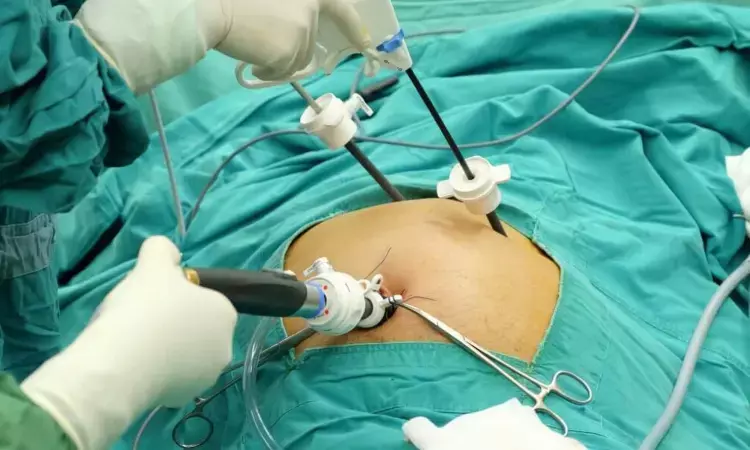- Home
- Medical news & Guidelines
- Anesthesiology
- Cardiology and CTVS
- Critical Care
- Dentistry
- Dermatology
- Diabetes and Endocrinology
- ENT
- Gastroenterology
- Medicine
- Nephrology
- Neurology
- Obstretics-Gynaecology
- Oncology
- Ophthalmology
- Orthopaedics
- Pediatrics-Neonatology
- Psychiatry
- Pulmonology
- Radiology
- Surgery
- Urology
- Laboratory Medicine
- Diet
- Nursing
- Paramedical
- Physiotherapy
- Health news
- Fact Check
- Bone Health Fact Check
- Brain Health Fact Check
- Cancer Related Fact Check
- Child Care Fact Check
- Dental and oral health fact check
- Diabetes and metabolic health fact check
- Diet and Nutrition Fact Check
- Eye and ENT Care Fact Check
- Fitness fact check
- Gut health fact check
- Heart health fact check
- Kidney health fact check
- Medical education fact check
- Men's health fact check
- Respiratory fact check
- Skin and hair care fact check
- Vaccine and Immunization fact check
- Women's health fact check
- AYUSH
- State News
- Andaman and Nicobar Islands
- Andhra Pradesh
- Arunachal Pradesh
- Assam
- Bihar
- Chandigarh
- Chattisgarh
- Dadra and Nagar Haveli
- Daman and Diu
- Delhi
- Goa
- Gujarat
- Haryana
- Himachal Pradesh
- Jammu & Kashmir
- Jharkhand
- Karnataka
- Kerala
- Ladakh
- Lakshadweep
- Madhya Pradesh
- Maharashtra
- Manipur
- Meghalaya
- Mizoram
- Nagaland
- Odisha
- Puducherry
- Punjab
- Rajasthan
- Sikkim
- Tamil Nadu
- Telangana
- Tripura
- Uttar Pradesh
- Uttrakhand
- West Bengal
- Medical Education
- Industry
Subtotal cholecystectomy lowers risk of bile duct injury in tough gallbladders

UK: Subtotal cholecystectomy (STC) seems to be an effective technique to avoid common bile duct (CBD) injuries in difficult cholecystectomy cases; indicating it is a viable alternative to total cholecystectomy (TC) in these situations, a recent study has found.
"Subtotal cholecystectomy significantly reduced the risk of CBD injury compared to total cholecystectomy," the researchers reported in the Annals of the Royal College of Surgeons of England. However, compared to TC, STC raised the risk of postoperative endoscopic retrograde cholangiopancreatography (ERCP), bile leaks, need for reoperation, and intraabdominal collections."
Severe adhesions or inflammation can impede safe dissection in the hepatocystic triangle (HCT), leading to an intraoperative decision to perform subtotal cholecystectomy. The STC rate is likely to increase in the future as an increasing number of cholecystectomies are attempted in the acute setting when inflammation in the HCT may be at its peak. The term subtotal cholecystectomy is used when most of Hartmann’s pouch is left in situ with or without stump closure.
The study was conducted by Somaiah Aroori, University Hospitals Plymouth NHS Trust, UK, and colleagues to evaluate the safety profile of subtotal cholecystectomy.
For this purpose, the researchers retrospectively reviewed all patients who had STC between 2009 and 2019. STC was divided into two types, reconstituting (R-STC) and fenestrating (F-STC), depending on whether the gall bladder remnant was closed or left open. The study excluded patients who had cholecystectomy for gall bladder malignancy or as part of another operation.
The study led to the following findings:
- A total of 5,664 patients underwent cholecystectomy during the study period. Of these, 1.7% underwent subtotal cholecystectomy.
- The laparoscopic to open conversion rate was high at 48.8%, as was the overall postoperative complication rate (45.4%).
- No patient suffered iatrogenic bile duct injury.
- 19.6% of patients suffered postoperative bile leak. This was significantly higher in patients who had STC in the acute setting (41% versus 13% for elective STC cases).
- There was no significant difference in the rate of bile leak or other complications between R-STC and F-STC types. The 90-day readmission rate was 8.2%.
- No mortalities were recorded within 90 days post-STC.
The study revealed subtotal cholecystectomy to be an effective technique to prevent bile duct injury. However, it is associated with relatively high rates of postoperative morbidity, long hospital stays, and bile leaks.
The researcher suggests, "Surgeons should be aware of the implications of undergoing STC, and suitable precautions must be taken to minimise the STC risk."
"Patients should be informed of the risks of STC before planned TC and be consented to accordingly," they concluded.
Reference:
Ibrahim R, Abdalkoddus M, Mahendran B, Mownah OA, Nawara H, Aroori S. Subtotal cholecystectomy: is it a safe option for difficult gall bladders? Ann R Coll Surg Engl. 2023 May;105(5):455-460. doi: 10.1308/rcsann.2021.0291. Epub 2021 Nov 25. PMID: 34821508; PMCID: PMC10149244.
Dr Kamal Kant Kohli-MBBS, DTCD- a chest specialist with more than 30 years of practice and a flair for writing clinical articles, Dr Kamal Kant Kohli joined Medical Dialogues as a Chief Editor of Medical News. Besides writing articles, as an editor, he proofreads and verifies all the medical content published on Medical Dialogues including those coming from journals, studies,medical conferences,guidelines etc. Email: drkohli@medicaldialogues.in. Contact no. 011-43720751


